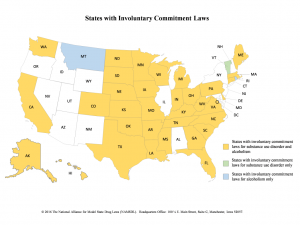In school, we all learned several ways to be a “good citizen”: vote, participate in community service, be a good neighbour, follow the rules, and treat others with respect. All of these are important responsibilities which contribute to a better society.
But did you ever stop to think about how you can be a good citizen by supporting people with mental illness? This is not something most of us were ever taught when we were growing up.
Consequently, many intelligent, well-intentioned people don’t know much about mental illness or are misinformed about what it is, and they may feel uncomfortable around people with mental illness. Also, the comments or words they use to describe people with mental illness are sometimes insensitive or disrespectful.
So what if you want to help but you aren’t sure how to begin? Let me suggest several simple but important ways you can learn how to be that “good citizen” and clearly show your support for people with mental illness. I’ve listed them in order, from options that take little effort to ones that may require a larger commitment of your time and energy.
Learn the facts
Understand the basic facts about mental illnesses. Mental illness can affect anyone, and 1 in 4 adults will experience a mental illness in a given year. Treatment is effective, it’s widely available, and people do recover, but over half of the people with a mental illness never receive care. One good resource to learn some of the basics is this fact sheet from the National Alliance on Mental Illness (NAMI).
Shatter the myths
As you learn the facts, it’s also important to understand and debunk some of the myths surrounding mental illnesses. For example, it’s often stated that people with mental illness are prone to be violent. Actually, they are no more likely to be violent than anyone else. In fact, they are 10 times more likely to be the victims of violent crime. Another incorrect assumption is that mental illnesses are just a weakness or character flaw. The fact is they are disorders influenced by many biological and environmental factors. Check out this article from the US Department of Health and Human Services to see more of these myths and the real facts.
Show respect
Many negative terms and labels are used to describe people with mental illness. Insensitive or inappropriate language creates stigma and discrimination toward people with mental illness. It’s vital to respect the dignity of each individual, regardless of their mental health issues or diagnosis. The recommended rule of thumb is to use “person-first” or “people-first” language, which focuses more on the person, and doesn’t define them by their illness. For example, it’s better to say “Mary has schizophrenia” rather than “Mary is a schizophrenic.” To learn more about people-first language guidelines, here’s a useful brochure from the Hogg Foundation for Mental Health.
Make a donation
Make a donation to one of the many organizations that do great work in support, education and advocacy for people with mental illness and their loved ones. Since there are several terrific ones, I won’t make specific endorsements, but just search online or ask local mental health contacts to help identify some of these types of organizations. Then make a contribution to one or more groups that are fighting the good fight. While monetary donations are always welcome, many groups will also gladly accept contributions of gently used items such as electronics or clothing.
Get a first-hand account
Another simple but meaningful way to support people with mental illness is to understand their life experiences, their challenges, and their personal victories. Sit down and talk with someone who is willing to share their story about their own illness. Or read one of the many excellent autobiographical accounts of people who have dealt with mental illness and who have thrived despite facing significant obstacles on their path to recovery.
Attend an event
Attend a mental health event in your area to learn more about mental illnesses and efforts to promote better mental health services. This is also a great opportunity to meet persons with mental illness, advocates, and other supporters of mental health initiatives. Many groups will offer free seminars, charity walks, support groups, family support and educational resources to help you become more aware of current issues related to mental health care in your community and across the nation.
Volunteer
Offer a few hours of your time on a regular basis to do volunteer work for one of the organizations that offer services and supports for people with mental illness. In this way you can further increase your knowledge and awareness and also gain satisfaction from directly helping others who need support. Be enthusiastic in promoting the good works of the organization and recruit others to help with their worthy causes.
Help someone in need
If you have friends, family members, neighbours, co-workers or other contacts who are struggling with mental illness or perhaps just emotional distress, reach out to them. Help them connect with resources such as local mental health support organizations, useful books and websites, and how to access professional help if they are having significant concerns or they are in crisis.
Consider further advocacy
Take your support for people with mental illness to the next level by getting involved in legislative advocacy. Share your views and concerns about the mental health system with your legislators and policy-makers. Connect with other mental health advocates who are working to create or amend laws and policies that will improve services and supports for people with mental illness.
Through these important steps, you can become a good…no, a great citizen as you support people with mental illness. Take action now. The need is great. With your generosity, enthusiasm, knowledge, respect, and compassion, you really can make a difference.
Here’s a question and a call to action: What can you do now to help support someone with a mental illness? Please leave a comment. Also please consider subscribing to my blog and feel free to follow me on Twitter, or “like” my Facebook page. Thanks!


